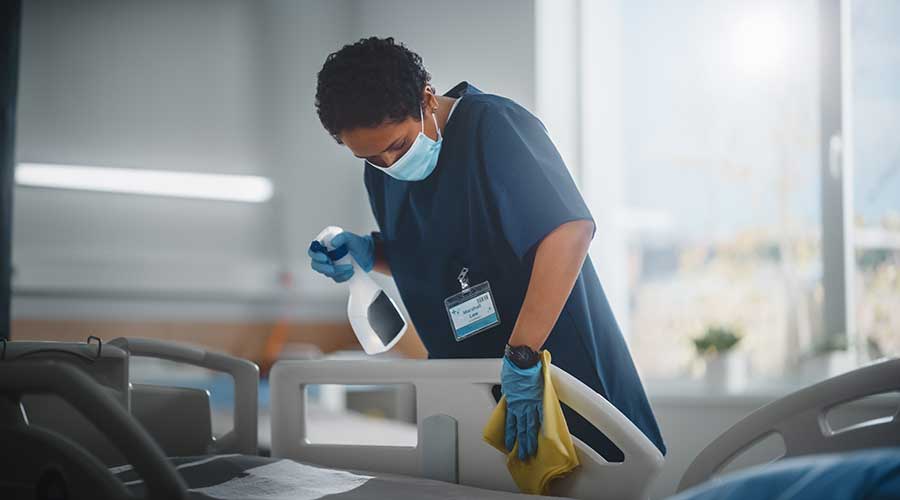The Association for Professionals in Infection Control and Epidemiology (APIC) reported the welcome news late last year that the U.S. Department of Labor has developed a first-of-its-kind framework for infection preventionist (IP) apprenticeship programs.
The Urban Institute, a nonprofit research organization, received a grant to develop an infrastructure of occupational standards for registered apprenticeship programs, helping accelerate the expansion of such programs throughout the United States. The institute collaborated with APIC on building the framework for IP apprenticeship programs.
I suggest developing a similar apprenticeship program for healthcare environmental services technicians that leads to certification. The learning objectives for a certified environmental services technician (CEST) could be as follows:
- Define infection prevention as the No. 1 job of environmental services.
- Equip the front-line cleaning professional (CP) with knowledge of infection prevention as it relates to their daily tasks.
- Analyze the CP’s role in patient satisfaction.
- Support the CP with practical how-to tips for cleaning and disinfecting.
- Introduce cleaning and disinfecting strategies that effectively break the chain of infection.
- Convert the CP into a CEST.
Environmental service workers play an essential role in prevention of healthcare-associated infections. Recent studies have demonstrated significant improvements in cleaning through interventions directed at environmental service workers. For optimal effectiveness, such interventions require that these workers be knowledgeable about the prevention and transmission of disease and well trained on the best practices that keep patients safe.
The stakes are too high to allow someone who is not a CEST to clean patient rooms. The CEST must be properly compensated, regarded as a part of the facility’s multi-modal infection prevention program, be well trained in the nuances of cleaning and disinfection, have time to do the necessary tasks, be equipped with the best-in-class tools to clean and disinfect surfaces and be educated about the prevention and transmission of disease.
An educated CEST will be viewed as a knowledgeable professional working amongst other healthcare professionals who are certified or registered in their fields. Knowledge leads the environmental services worker to be proud of the profession they have chosen and respected by those they work alongside.
With the development of the framework, we aim to support a highly skilled workforce dedicated to safe-guarding public health and look forward to the positive impact it will have on infection prevention.
We are a nation of immigrants, many of whom have come to America because of employment opportunities. We have environmental services departments in hospitals that are competing with other industries for low-skilled workers and have turnover rates exceeding 30 percent of their workforce, many of whom are burned out from working 50 hours a week. Could an occupational framework for an apprenticeship program that leads to CESTs on the frontlines of infection prevention solve both problems?
One well-trained, well-equipped, conscientious CEST, given the proper tools and an adequate amount of time to clean and disinfect a patient room, can prevent more infections than a room full of doctors can cure.
J. Darrel Hicks, BA, MESRE, CHESP, Certificate of Mastery in Infection Prevention, is the past president of the Healthcare Surfaces Institute. Hicks is nationally recognized as a subject matter expert in infection prevention and control as it relates to cleaning. He is the owner and principal of Safe, Clean and Disinfected. His enterprise specializes in B2B consulting, webinar presentations, seminars and facility consulting services related to cleaning and disinfection. He can be reached at darrel@darrelhicks.com, or learn more at www.darrelhicks.com.

 Code Compliance Isn't Enough for Healthcare Resilience
Code Compliance Isn't Enough for Healthcare Resilience Ribbon Cutting Marks First Phase Completion for New Montefiore Einstein Facility
Ribbon Cutting Marks First Phase Completion for New Montefiore Einstein Facility Brooks Rehabilitation Launches 3 New Major Construction Projects
Brooks Rehabilitation Launches 3 New Major Construction Projects Joint Commission Standards: What Updates Matter Most?
Joint Commission Standards: What Updates Matter Most? Swinerton Completes Construction at Atlanta's Grady Hospital
Swinerton Completes Construction at Atlanta's Grady Hospital